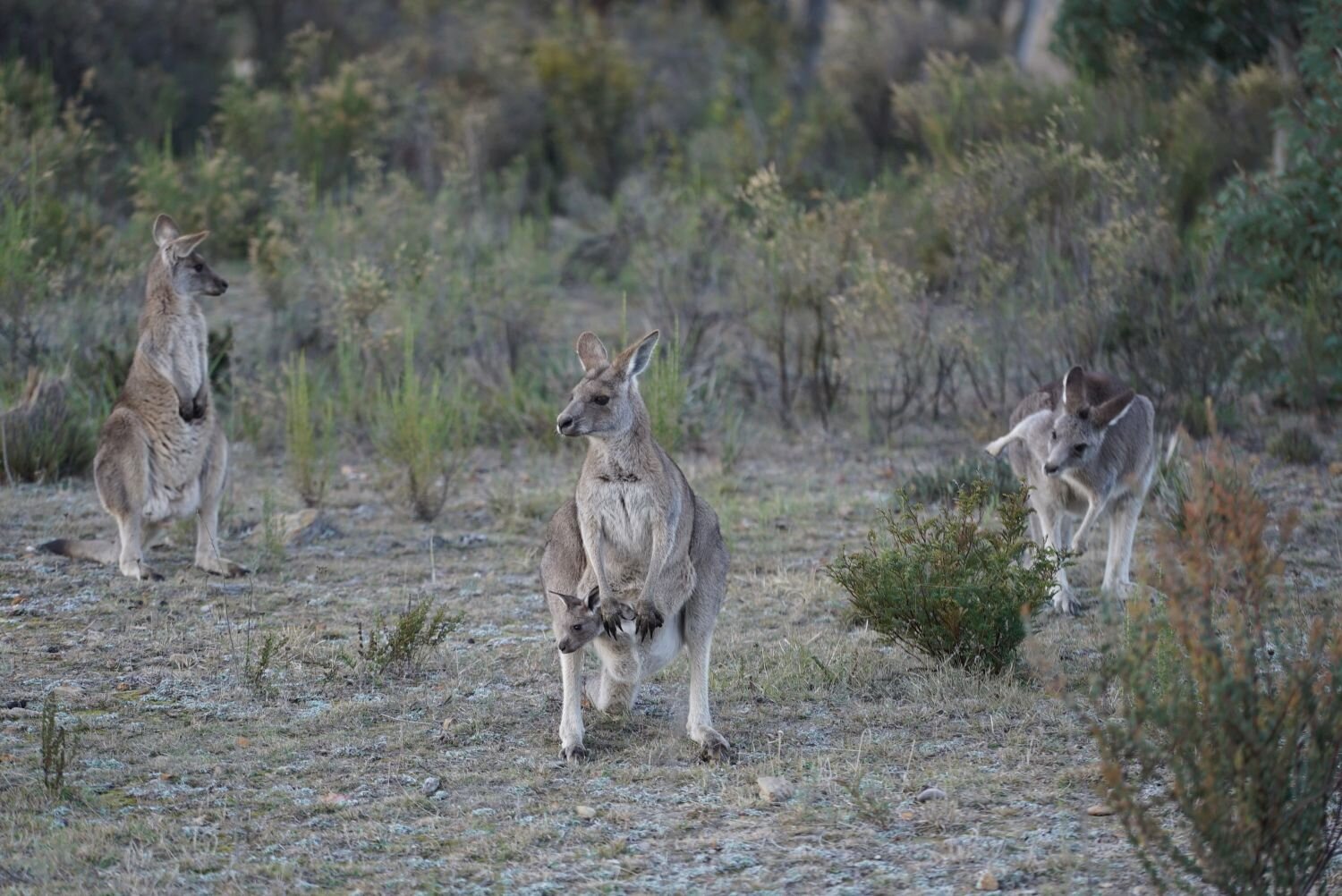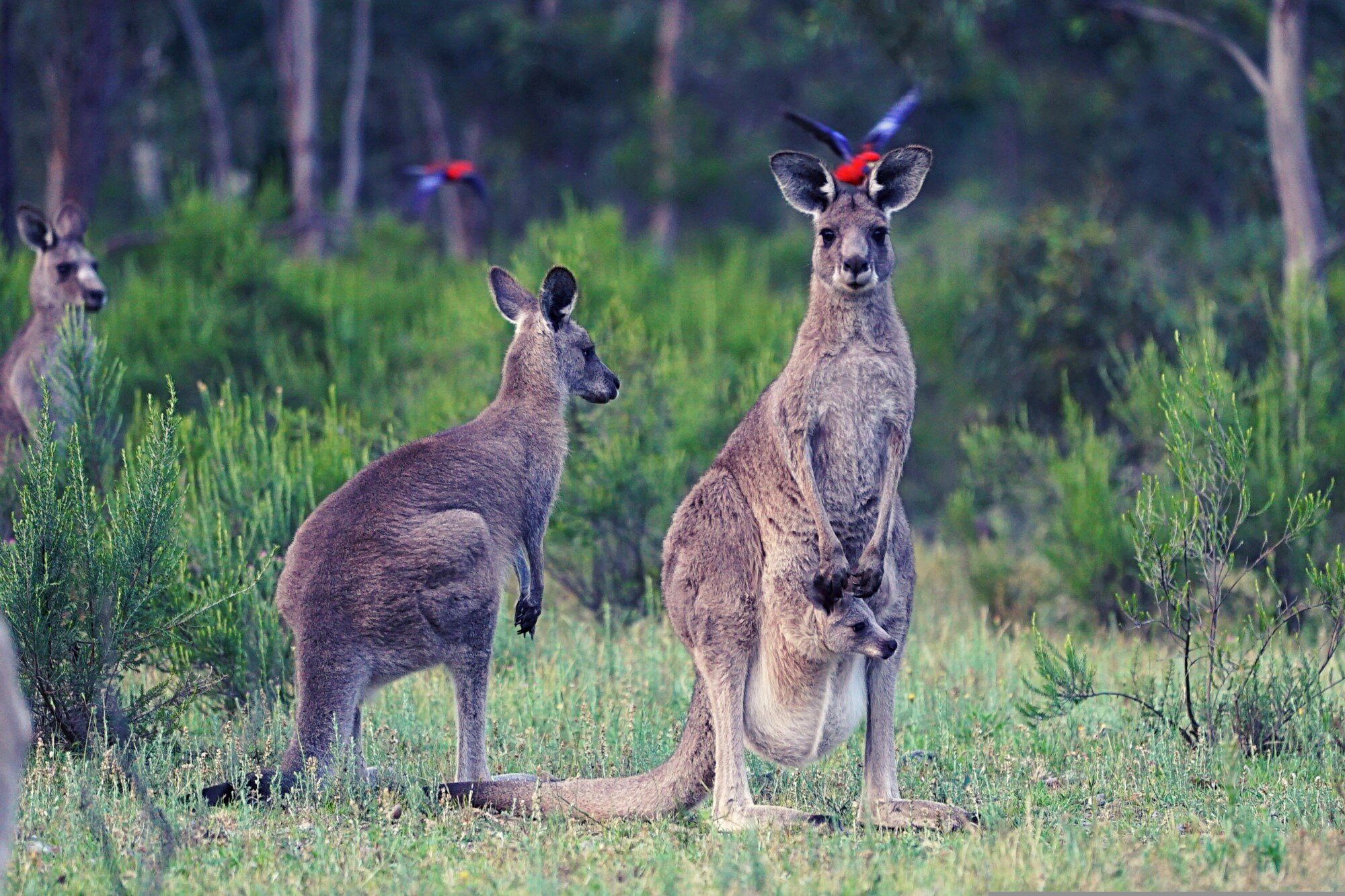
Meet the Mob
EASTERN GREY KANGAROOS have hind legs that are larger than their forelimbs. Their hind feet are also large and powerful. Their long muscular tail is used for balance when hopping and as a fifth limb when movements are slow. The fur is a light grey woolly colour except the face which is darker. A dark tip of fur is also found on the tail.
They are found in habitats ranging from semi-arid mallee scrub through to woodlands, some farmland areas with remnant vegetation and forest.
The Eastern Grey Kangaroos are herbivorous, favouring grasses and preferring to eat young green shoots high in protein. Being nocturnal, large ‘mobs’ will gather at dusk to feed where food is most abundant. They usually rest in the shade or shelter of trees or scrubs moving out to graze from late afternoon to early morning when they will congregate in the open. They communicate via a series of clucking sounds.
The tendons in the legs of kangaroos act like sprung ropes and help propel the animal at fast speed with minimum effort. The highest recorded speed was set by a female Eastern Grey Kangaroo at 64km/hr.
Breeding is continuous throughout the year and reaches a peak in summer. The newborn ‘joey’ which weighs less than one gram is born thirty six days after mating. It climbs unaided into the pouch and shortly afterwards attaches to one of the four teats. The young kangaroo is raised in the pouch until it can survive outside. At about 9 months the joey will begin to leave the pouch but continues to suckle from time to time. A joey becomes independent at about 18 months of age.
https://australianmuseum.net.au/
Bennett’s Wallaby by Noodle snacks - Own work, CC BY-SA 3.0
RED-NECKED WALLABY can be distinguished from other wallabies by its white cheek markings and red colouring on the neck. The rest of its body fur is grey to reddish in colour with a white or pale grey abdomen. Their muzzle, paws and toes are black in colour. The Red-necked Wallaby is protected by law in all states of Australia.
The Red-necked Wallaby ranges throughout the eastern parts of Australia from the Queensland – New South Wales border area, right through to South Australia. It is also found in Tasmania. Found in subtropical, cool temperate, wet and dry sclerophyll forests, and woodland with adjacent grassy areas, this nocturnal animal spends most of the day resting amongst dense understory within the forest.
Usually this wallaby is a solitary animal, but may be seen grazing from late afternoon to dawn in grassy areas in groups. The Red-necked Wallaby eats mainly grasses and herbs, and likes areas that are partially cleared with surrounding patches of sheltered forest.
A female is able to breed at the age of around 14 months while a male comes into sexual maturity at around 19 months of age. The pouch life for a Red-necked Wallaby joey is about 9 months, with the joey continuing to suckle till it is around 12-15 months of age. https://www.australiazoo.com.au/our-animals/mammals/kangaroos/red-necked-wallaby
SWAMP WALLABY is not as common as it once was, but can still be found in a few places in its preferred habitat of thick forest undergrowth or sandstone heath. This small, stocky wallaby has dark brown fur, often with lighter rusty patches on the belly, chest and base of the ears. The Swamp Wallaby feeds on a variety of plants including introduced and native shrubs, grasses and ferns. Like many marsupials, female Swamp Wallabies can suckle two joeys of different ages. The pouch life of each joey is eight to nine months, although they may continue to suckle until 15 months of age. Breeding occurs throughout the year in Swamp Wallabies.
https://australianmuseum.net.au/
Ltshears - Own work Wallaroo Macropus robustus at Louisville Zoo CC BY-SA 3.0
WALLAROO is a medium to large macropod. As the name suggests, it looks like a mix between a wallaby and a kangaroo.
The word “wallaroo” is from Dharug walaru. In general, a large, slim-bodied macropod of the open plains is called a “kangaroo”; a small to medium-sized one, particularly if it is relatively thick-set, is a “wallaby”: most wallaroos are only a little smaller than a kangaroo, fairly thickset, and are found in open country. All share a particular habit of stance: wrists raised, elbows tucked close into the body, and shoulders thrown back, and all have a large, black-skinned rhinarium.
The common wallaroo (Macropus robustus or wallaroo) is the best-known species. There are four subspecies of the common wallaroo: the eastern wallaroo and the euro, which are both widespread, and two of more restricted range, one from Barrow Island, the other from the Kimberley.
The black wallaroo (Macropus bernardus) occupies an area of steep, rocky ground in Arnhem Land. At around 60 to 70 cm (24 to 28 inches) in length (excluding tail) it is the smallest wallaroo and the most heavily built. Males weigh 19 to 22 kg (42 to 49 lb), females about 13 kg (29 lb). Because it is very wary and is found only in a small area of remote and very rugged country, it is little known.
Macropus antilopinus is the exception among wallaroos. It is, essentially, the far-northern equivalent of the eastern and western grey kangaroos. Like them, it is a creature of the grassy plains and woodlands, and gregarious, where the other wallaroos are solitary. https://en.wikipedia.org/wiki/Wallaroo




